Telstra Marketing Strategies
VerifiedAdded on 2023/03/17
|12
|4520
|87
AI Summary
This study assesses Telstra's marketing strategies and tools for successful targeting of customers. It analyzes Telstra's 5Cs (company, customer, competitor, collaborators, and context), explores how the company collects information about these factors, and recommends marketing strategies for a potential new market segment.
Contribute Materials
Your contribution can guide someone’s learning journey. Share your
documents today.
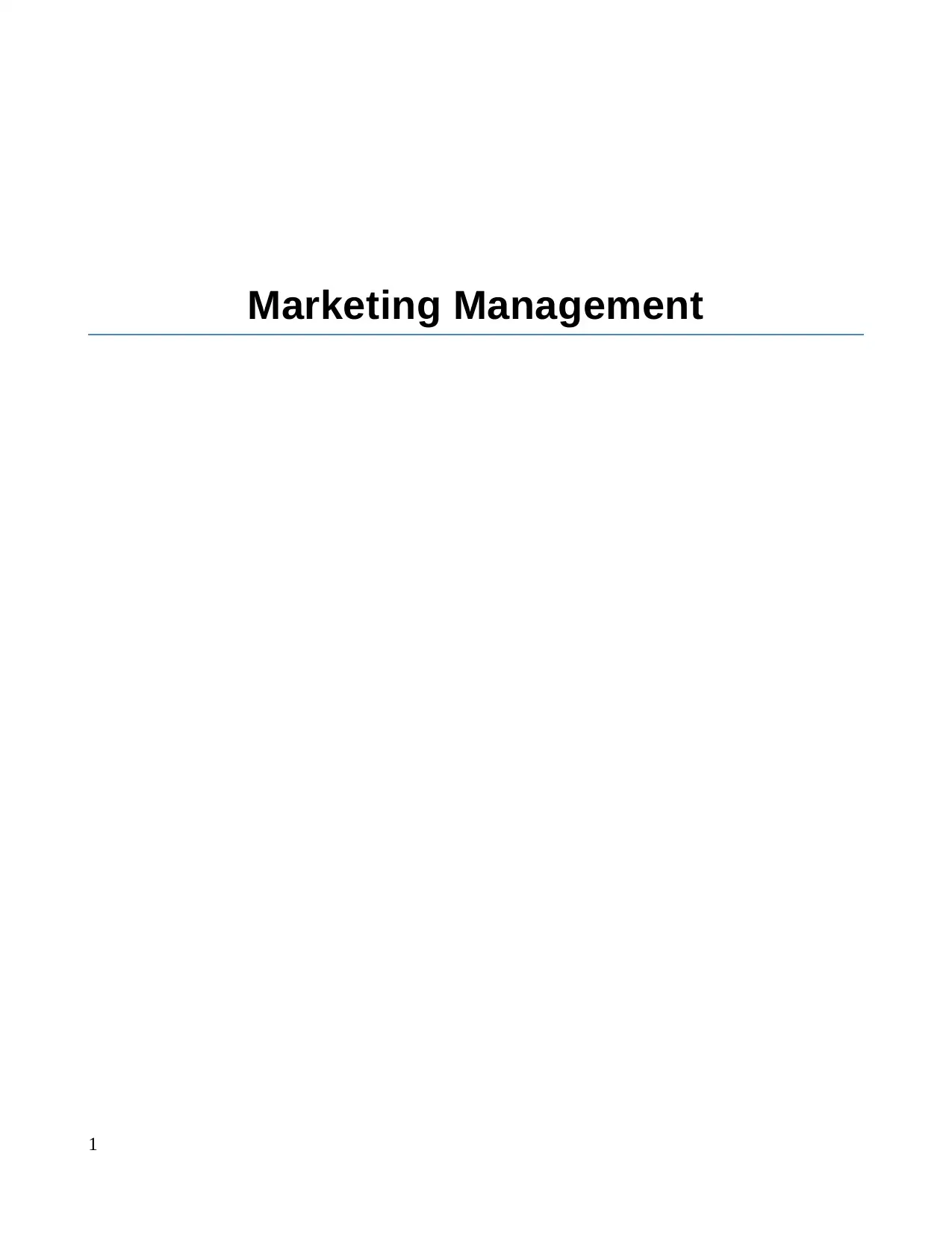
Marketing Management
1
1
Secure Best Marks with AI Grader
Need help grading? Try our AI Grader for instant feedback on your assignments.
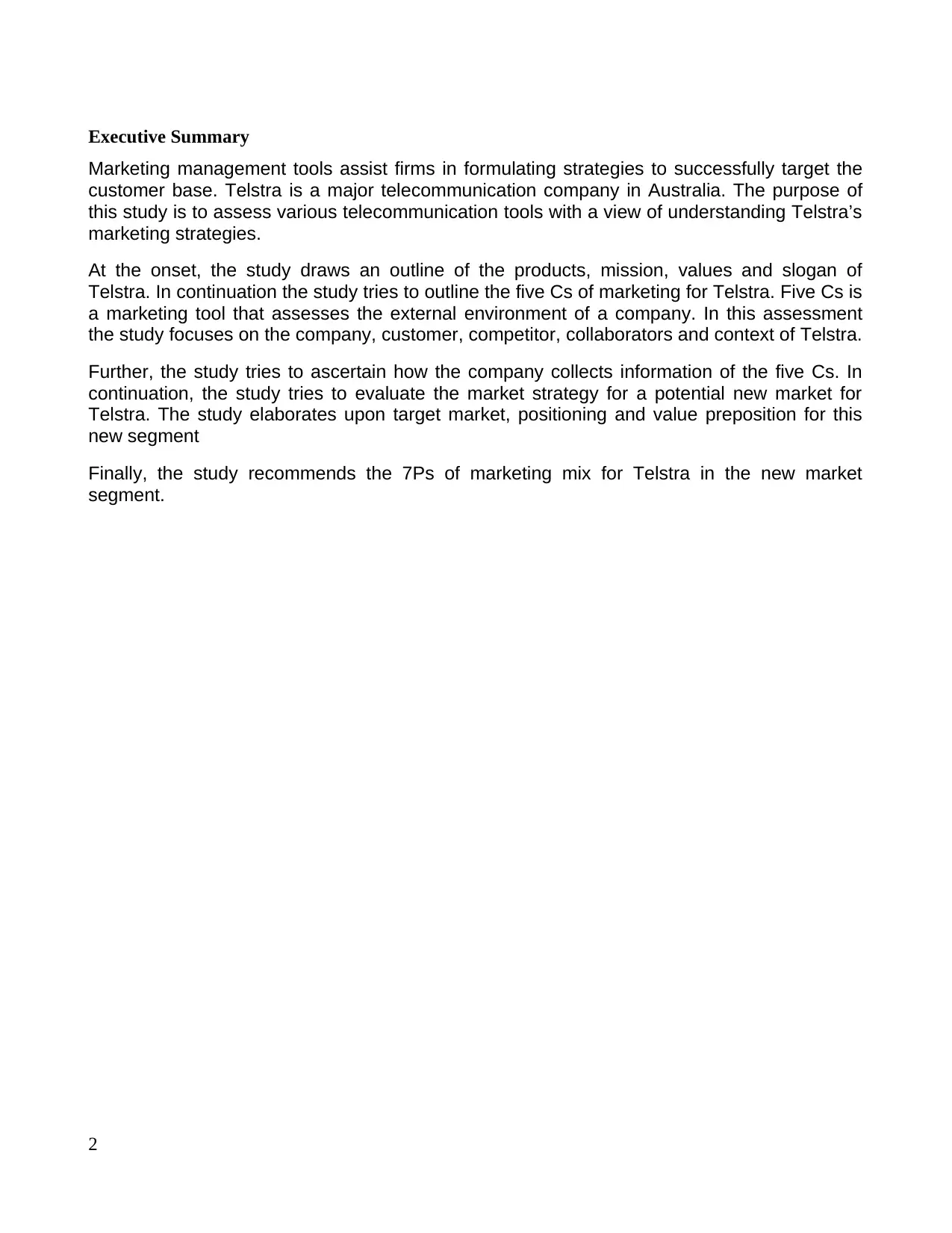
Executive Summary
Marketing management tools assist firms in formulating strategies to successfully target the
customer base. Telstra is a major telecommunication company in Australia. The purpose of
this study is to assess various telecommunication tools with a view of understanding Telstra’s
marketing strategies.
At the onset, the study draws an outline of the products, mission, values and slogan of
Telstra. In continuation the study tries to outline the five Cs of marketing for Telstra. Five Cs is
a marketing tool that assesses the external environment of a company. In this assessment
the study focuses on the company, customer, competitor, collaborators and context of Telstra.
Further, the study tries to ascertain how the company collects information of the five Cs. In
continuation, the study tries to evaluate the market strategy for a potential new market for
Telstra. The study elaborates upon target market, positioning and value preposition for this
new segment
Finally, the study recommends the 7Ps of marketing mix for Telstra in the new market
segment.
2
Marketing management tools assist firms in formulating strategies to successfully target the
customer base. Telstra is a major telecommunication company in Australia. The purpose of
this study is to assess various telecommunication tools with a view of understanding Telstra’s
marketing strategies.
At the onset, the study draws an outline of the products, mission, values and slogan of
Telstra. In continuation the study tries to outline the five Cs of marketing for Telstra. Five Cs is
a marketing tool that assesses the external environment of a company. In this assessment
the study focuses on the company, customer, competitor, collaborators and context of Telstra.
Further, the study tries to ascertain how the company collects information of the five Cs. In
continuation, the study tries to evaluate the market strategy for a potential new market for
Telstra. The study elaborates upon target market, positioning and value preposition for this
new segment
Finally, the study recommends the 7Ps of marketing mix for Telstra in the new market
segment.
2
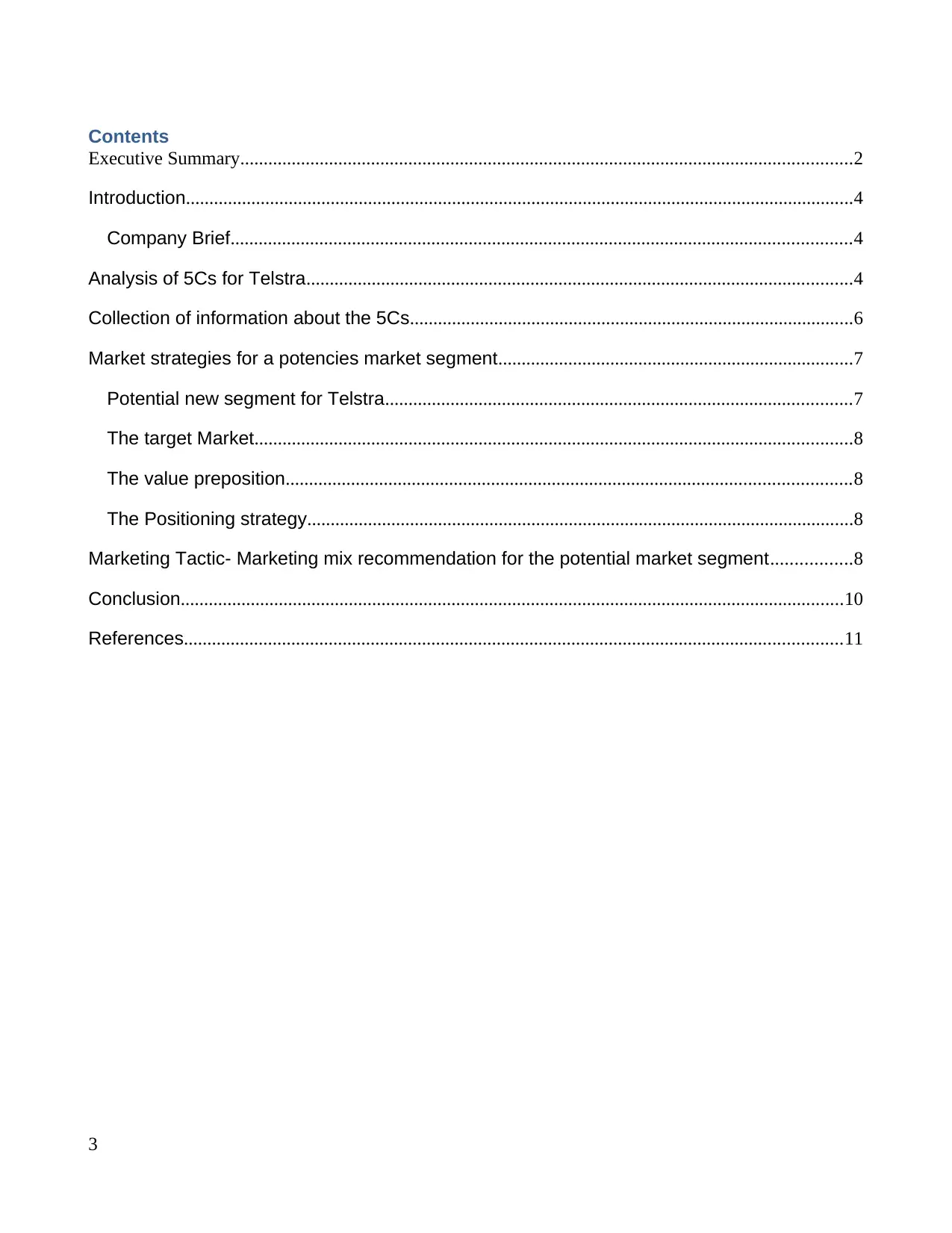
Contents
Executive Summary...................................................................................................................................2
Introduction...............................................................................................................................................4
Company Brief.....................................................................................................................................4
Analysis of 5Cs for Telstra.....................................................................................................................4
Collection of information about the 5Cs...............................................................................................6
Market strategies for a potencies market segment............................................................................7
Potential new segment for Telstra....................................................................................................7
The target Market................................................................................................................................8
The value preposition.........................................................................................................................8
The Positioning strategy.....................................................................................................................8
Marketing Tactic- Marketing mix recommendation for the potential market segment.................8
Conclusion..............................................................................................................................................10
References.............................................................................................................................................11
3
Executive Summary...................................................................................................................................2
Introduction...............................................................................................................................................4
Company Brief.....................................................................................................................................4
Analysis of 5Cs for Telstra.....................................................................................................................4
Collection of information about the 5Cs...............................................................................................6
Market strategies for a potencies market segment............................................................................7
Potential new segment for Telstra....................................................................................................7
The target Market................................................................................................................................8
The value preposition.........................................................................................................................8
The Positioning strategy.....................................................................................................................8
Marketing Tactic- Marketing mix recommendation for the potential market segment.................8
Conclusion..............................................................................................................................................10
References.............................................................................................................................................11
3
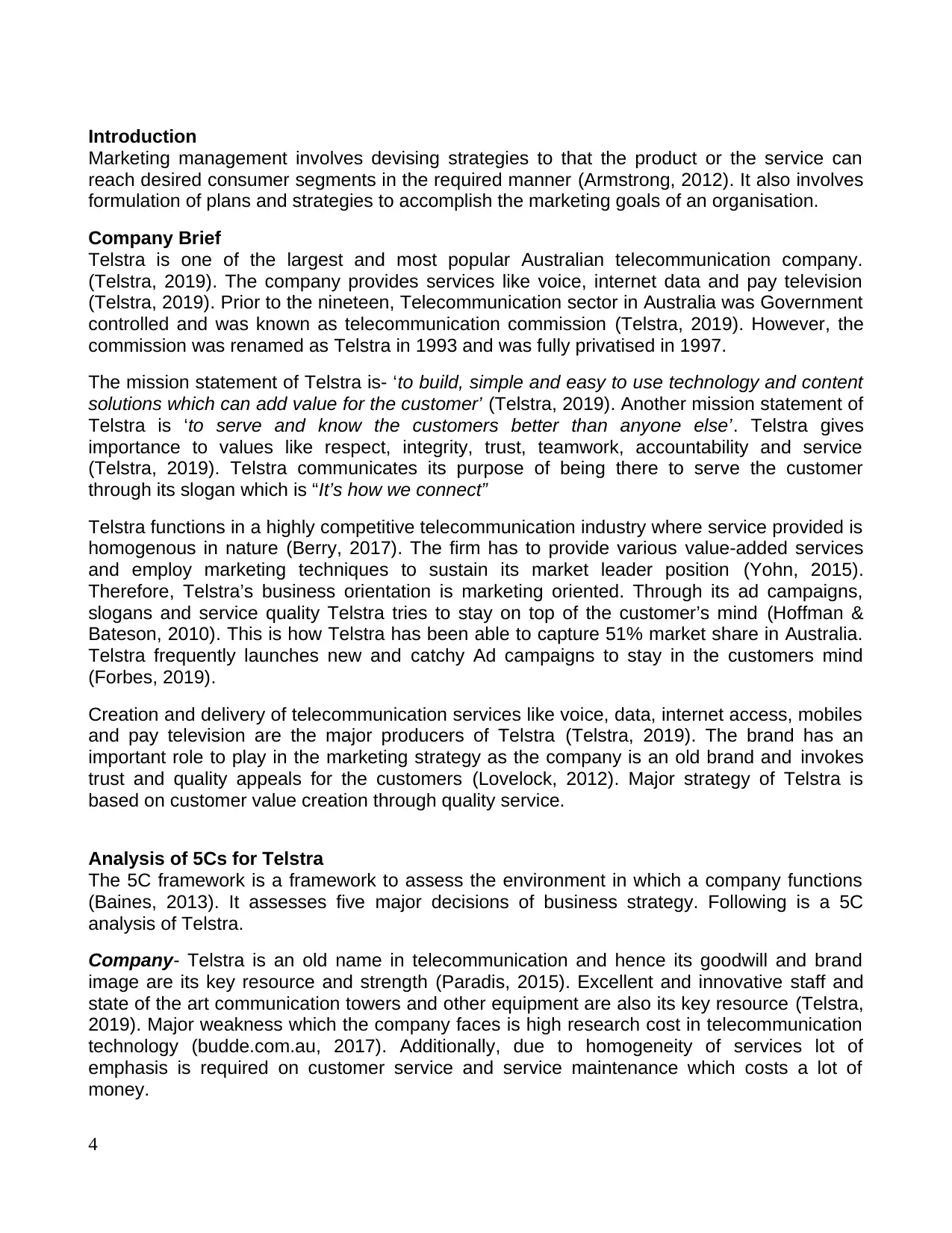
Introduction
Marketing management involves devising strategies to that the product or the service can
reach desired consumer segments in the required manner (Armstrong, 2012). It also involves
formulation of plans and strategies to accomplish the marketing goals of an organisation.
Company Brief
Telstra is one of the largest and most popular Australian telecommunication company.
(Telstra, 2019). The company provides services like voice, internet data and pay television
(Telstra, 2019). Prior to the nineteen, Telecommunication sector in Australia was Government
controlled and was known as telecommunication commission (Telstra, 2019). However, the
commission was renamed as Telstra in 1993 and was fully privatised in 1997.
The mission statement of Telstra is- ‘to build, simple and easy to use technology and content
solutions which can add value for the customer’ (Telstra, 2019). Another mission statement of
Telstra is ‘to serve and know the customers better than anyone else’. Telstra gives
importance to values like respect, integrity, trust, teamwork, accountability and service
(Telstra, 2019). Telstra communicates its purpose of being there to serve the customer
through its slogan which is “It’s how we connect”
Telstra functions in a highly competitive telecommunication industry where service provided is
homogenous in nature (Berry, 2017). The firm has to provide various value-added services
and employ marketing techniques to sustain its market leader position (Yohn, 2015).
Therefore, Telstra’s business orientation is marketing oriented. Through its ad campaigns,
slogans and service quality Telstra tries to stay on top of the customer’s mind (Hoffman &
Bateson, 2010). This is how Telstra has been able to capture 51% market share in Australia.
Telstra frequently launches new and catchy Ad campaigns to stay in the customers mind
(Forbes, 2019).
Creation and delivery of telecommunication services like voice, data, internet access, mobiles
and pay television are the major producers of Telstra (Telstra, 2019). The brand has an
important role to play in the marketing strategy as the company is an old brand and invokes
trust and quality appeals for the customers (Lovelock, 2012). Major strategy of Telstra is
based on customer value creation through quality service.
Analysis of 5Cs for Telstra
The 5C framework is a framework to assess the environment in which a company functions
(Baines, 2013). It assesses five major decisions of business strategy. Following is a 5C
analysis of Telstra.
Company- Telstra is an old name in telecommunication and hence its goodwill and brand
image are its key resource and strength (Paradis, 2015). Excellent and innovative staff and
state of the art communication towers and other equipment are also its key resource (Telstra,
2019). Major weakness which the company faces is high research cost in telecommunication
technology (budde.com.au, 2017). Additionally, due to homogeneity of services lot of
emphasis is required on customer service and service maintenance which costs a lot of
money.
4
Marketing management involves devising strategies to that the product or the service can
reach desired consumer segments in the required manner (Armstrong, 2012). It also involves
formulation of plans and strategies to accomplish the marketing goals of an organisation.
Company Brief
Telstra is one of the largest and most popular Australian telecommunication company.
(Telstra, 2019). The company provides services like voice, internet data and pay television
(Telstra, 2019). Prior to the nineteen, Telecommunication sector in Australia was Government
controlled and was known as telecommunication commission (Telstra, 2019). However, the
commission was renamed as Telstra in 1993 and was fully privatised in 1997.
The mission statement of Telstra is- ‘to build, simple and easy to use technology and content
solutions which can add value for the customer’ (Telstra, 2019). Another mission statement of
Telstra is ‘to serve and know the customers better than anyone else’. Telstra gives
importance to values like respect, integrity, trust, teamwork, accountability and service
(Telstra, 2019). Telstra communicates its purpose of being there to serve the customer
through its slogan which is “It’s how we connect”
Telstra functions in a highly competitive telecommunication industry where service provided is
homogenous in nature (Berry, 2017). The firm has to provide various value-added services
and employ marketing techniques to sustain its market leader position (Yohn, 2015).
Therefore, Telstra’s business orientation is marketing oriented. Through its ad campaigns,
slogans and service quality Telstra tries to stay on top of the customer’s mind (Hoffman &
Bateson, 2010). This is how Telstra has been able to capture 51% market share in Australia.
Telstra frequently launches new and catchy Ad campaigns to stay in the customers mind
(Forbes, 2019).
Creation and delivery of telecommunication services like voice, data, internet access, mobiles
and pay television are the major producers of Telstra (Telstra, 2019). The brand has an
important role to play in the marketing strategy as the company is an old brand and invokes
trust and quality appeals for the customers (Lovelock, 2012). Major strategy of Telstra is
based on customer value creation through quality service.
Analysis of 5Cs for Telstra
The 5C framework is a framework to assess the environment in which a company functions
(Baines, 2013). It assesses five major decisions of business strategy. Following is a 5C
analysis of Telstra.
Company- Telstra is an old name in telecommunication and hence its goodwill and brand
image are its key resource and strength (Paradis, 2015). Excellent and innovative staff and
state of the art communication towers and other equipment are also its key resource (Telstra,
2019). Major weakness which the company faces is high research cost in telecommunication
technology (budde.com.au, 2017). Additionally, due to homogeneity of services lot of
emphasis is required on customer service and service maintenance which costs a lot of
money.
4
Secure Best Marks with AI Grader
Need help grading? Try our AI Grader for instant feedback on your assignments.
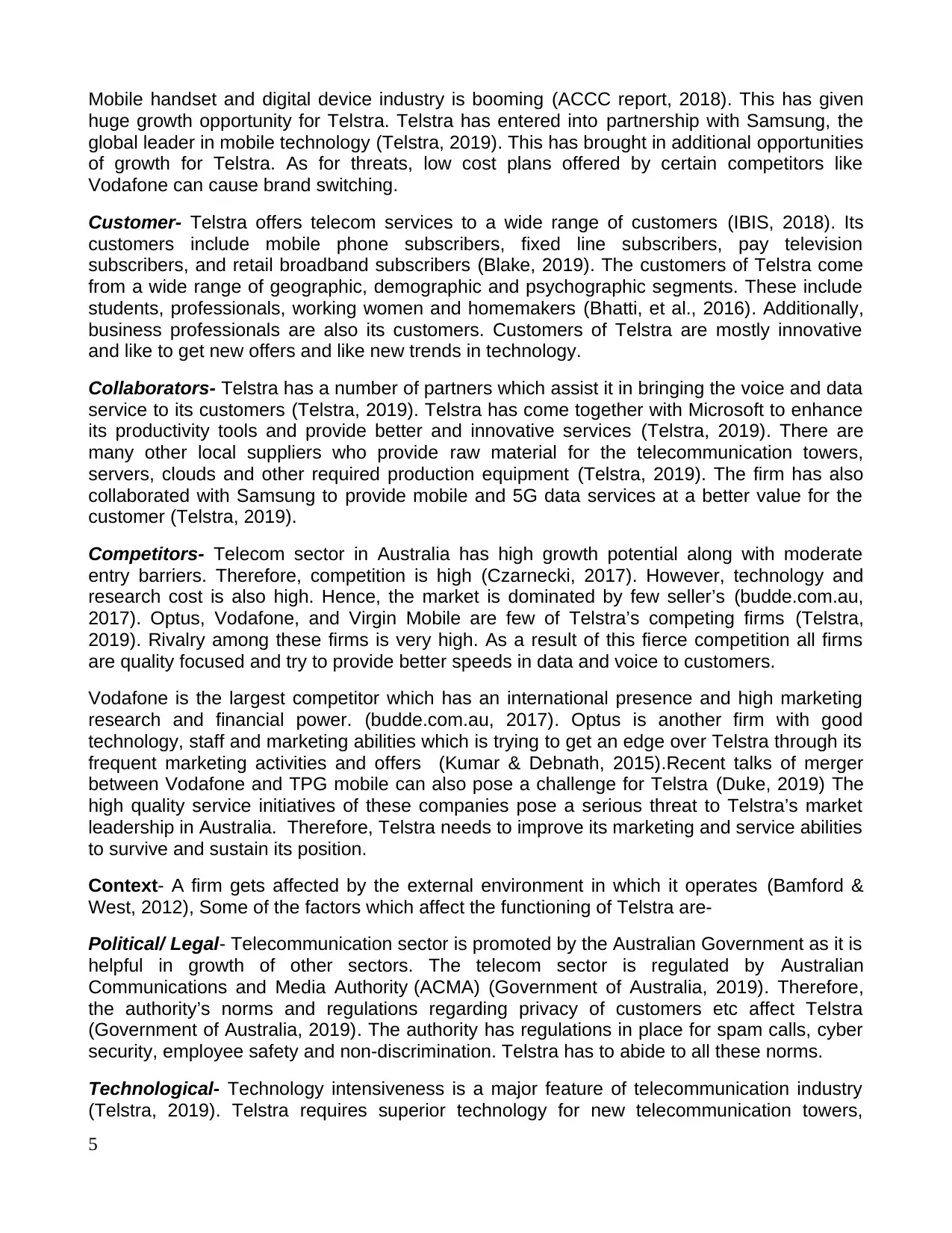
Mobile handset and digital device industry is booming (ACCC report, 2018). This has given
huge growth opportunity for Telstra. Telstra has entered into partnership with Samsung, the
global leader in mobile technology (Telstra, 2019). This has brought in additional opportunities
of growth for Telstra. As for threats, low cost plans offered by certain competitors like
Vodafone can cause brand switching.
Customer- Telstra offers telecom services to a wide range of customers (IBIS, 2018). Its
customers include mobile phone subscribers, fixed line subscribers, pay television
subscribers, and retail broadband subscribers (Blake, 2019). The customers of Telstra come
from a wide range of geographic, demographic and psychographic segments. These include
students, professionals, working women and homemakers (Bhatti, et al., 2016). Additionally,
business professionals are also its customers. Customers of Telstra are mostly innovative
and like to get new offers and like new trends in technology.
Collaborators- Telstra has a number of partners which assist it in bringing the voice and data
service to its customers (Telstra, 2019). Telstra has come together with Microsoft to enhance
its productivity tools and provide better and innovative services (Telstra, 2019). There are
many other local suppliers who provide raw material for the telecommunication towers,
servers, clouds and other required production equipment (Telstra, 2019). The firm has also
collaborated with Samsung to provide mobile and 5G data services at a better value for the
customer (Telstra, 2019).
Competitors- Telecom sector in Australia has high growth potential along with moderate
entry barriers. Therefore, competition is high (Czarnecki, 2017). However, technology and
research cost is also high. Hence, the market is dominated by few seller’s (budde.com.au,
2017). Optus, Vodafone, and Virgin Mobile are few of Telstra’s competing firms (Telstra,
2019). Rivalry among these firms is very high. As a result of this fierce competition all firms
are quality focused and try to provide better speeds in data and voice to customers.
Vodafone is the largest competitor which has an international presence and high marketing
research and financial power. (budde.com.au, 2017). Optus is another firm with good
technology, staff and marketing abilities which is trying to get an edge over Telstra through its
frequent marketing activities and offers (Kumar & Debnath, 2015).Recent talks of merger
between Vodafone and TPG mobile can also pose a challenge for Telstra (Duke, 2019) The
high quality service initiatives of these companies pose a serious threat to Telstra’s market
leadership in Australia. Therefore, Telstra needs to improve its marketing and service abilities
to survive and sustain its position.
Context- A firm gets affected by the external environment in which it operates (Bamford &
West, 2012), Some of the factors which affect the functioning of Telstra are-
Political/ Legal- Telecommunication sector is promoted by the Australian Government as it is
helpful in growth of other sectors. The telecom sector is regulated by Australian
Communications and Media Authority (ACMA) (Government of Australia, 2019). Therefore,
the authority’s norms and regulations regarding privacy of customers etc affect Telstra
(Government of Australia, 2019). The authority has regulations in place for spam calls, cyber
security, employee safety and non-discrimination. Telstra has to abide to all these norms.
Technological- Technology intensiveness is a major feature of telecommunication industry
(Telstra, 2019). Telstra requires superior technology for new telecommunication towers,
5
huge growth opportunity for Telstra. Telstra has entered into partnership with Samsung, the
global leader in mobile technology (Telstra, 2019). This has brought in additional opportunities
of growth for Telstra. As for threats, low cost plans offered by certain competitors like
Vodafone can cause brand switching.
Customer- Telstra offers telecom services to a wide range of customers (IBIS, 2018). Its
customers include mobile phone subscribers, fixed line subscribers, pay television
subscribers, and retail broadband subscribers (Blake, 2019). The customers of Telstra come
from a wide range of geographic, demographic and psychographic segments. These include
students, professionals, working women and homemakers (Bhatti, et al., 2016). Additionally,
business professionals are also its customers. Customers of Telstra are mostly innovative
and like to get new offers and like new trends in technology.
Collaborators- Telstra has a number of partners which assist it in bringing the voice and data
service to its customers (Telstra, 2019). Telstra has come together with Microsoft to enhance
its productivity tools and provide better and innovative services (Telstra, 2019). There are
many other local suppliers who provide raw material for the telecommunication towers,
servers, clouds and other required production equipment (Telstra, 2019). The firm has also
collaborated with Samsung to provide mobile and 5G data services at a better value for the
customer (Telstra, 2019).
Competitors- Telecom sector in Australia has high growth potential along with moderate
entry barriers. Therefore, competition is high (Czarnecki, 2017). However, technology and
research cost is also high. Hence, the market is dominated by few seller’s (budde.com.au,
2017). Optus, Vodafone, and Virgin Mobile are few of Telstra’s competing firms (Telstra,
2019). Rivalry among these firms is very high. As a result of this fierce competition all firms
are quality focused and try to provide better speeds in data and voice to customers.
Vodafone is the largest competitor which has an international presence and high marketing
research and financial power. (budde.com.au, 2017). Optus is another firm with good
technology, staff and marketing abilities which is trying to get an edge over Telstra through its
frequent marketing activities and offers (Kumar & Debnath, 2015).Recent talks of merger
between Vodafone and TPG mobile can also pose a challenge for Telstra (Duke, 2019) The
high quality service initiatives of these companies pose a serious threat to Telstra’s market
leadership in Australia. Therefore, Telstra needs to improve its marketing and service abilities
to survive and sustain its position.
Context- A firm gets affected by the external environment in which it operates (Bamford &
West, 2012), Some of the factors which affect the functioning of Telstra are-
Political/ Legal- Telecommunication sector is promoted by the Australian Government as it is
helpful in growth of other sectors. The telecom sector is regulated by Australian
Communications and Media Authority (ACMA) (Government of Australia, 2019). Therefore,
the authority’s norms and regulations regarding privacy of customers etc affect Telstra
(Government of Australia, 2019). The authority has regulations in place for spam calls, cyber
security, employee safety and non-discrimination. Telstra has to abide to all these norms.
Technological- Technology intensiveness is a major feature of telecommunication industry
(Telstra, 2019). Telstra requires superior technology for new telecommunication towers,
5
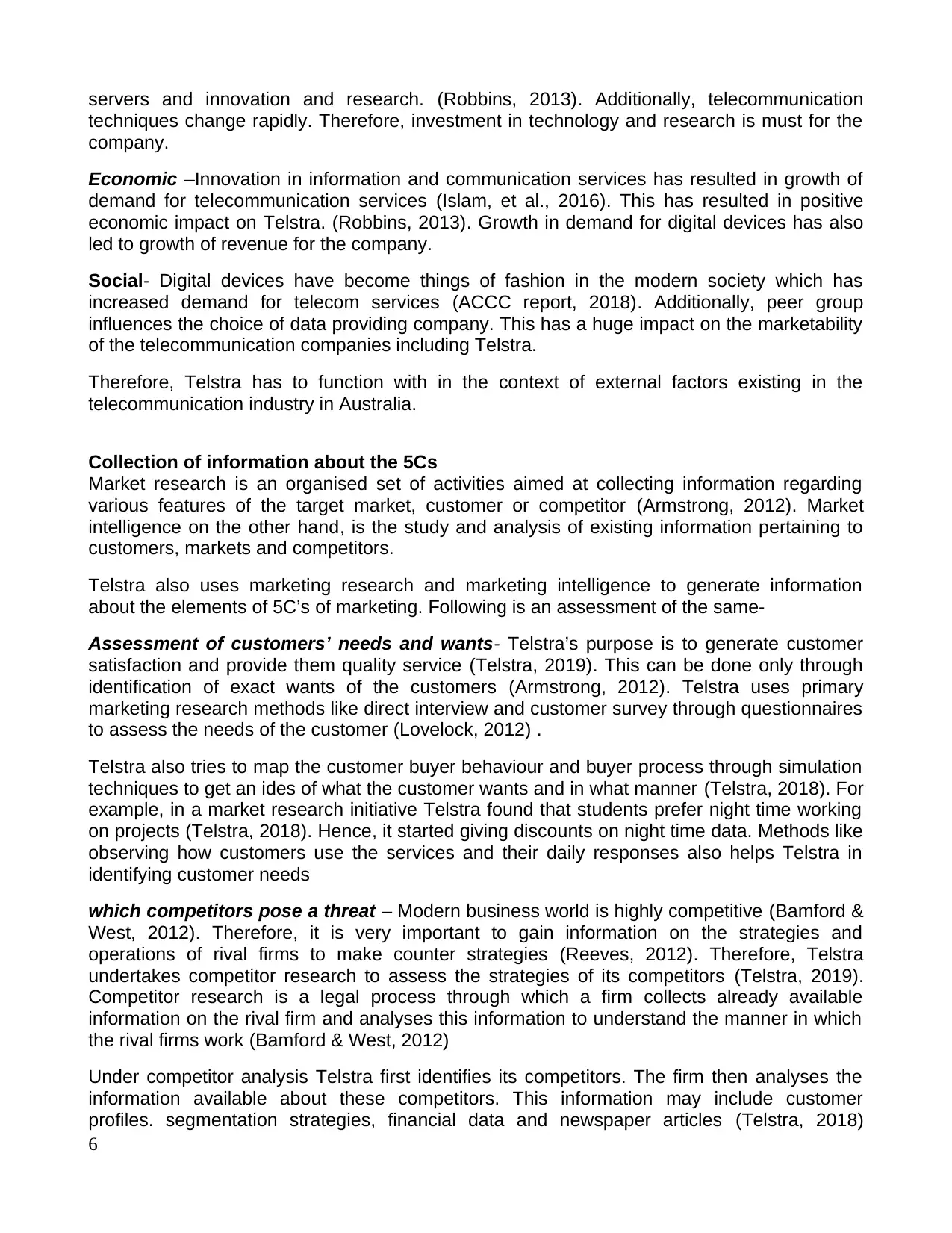
servers and innovation and research. (Robbins, 2013). Additionally, telecommunication
techniques change rapidly. Therefore, investment in technology and research is must for the
company.
Economic –Innovation in information and communication services has resulted in growth of
demand for telecommunication services (Islam, et al., 2016). This has resulted in positive
economic impact on Telstra. (Robbins, 2013). Growth in demand for digital devices has also
led to growth of revenue for the company.
Social- Digital devices have become things of fashion in the modern society which has
increased demand for telecom services (ACCC report, 2018). Additionally, peer group
influences the choice of data providing company. This has a huge impact on the marketability
of the telecommunication companies including Telstra.
Therefore, Telstra has to function with in the context of external factors existing in the
telecommunication industry in Australia.
Collection of information about the 5Cs
Market research is an organised set of activities aimed at collecting information regarding
various features of the target market, customer or competitor (Armstrong, 2012). Market
intelligence on the other hand, is the study and analysis of existing information pertaining to
customers, markets and competitors.
Telstra also uses marketing research and marketing intelligence to generate information
about the elements of 5C’s of marketing. Following is an assessment of the same-
Assessment of customers’ needs and wants- Telstra’s purpose is to generate customer
satisfaction and provide them quality service (Telstra, 2019). This can be done only through
identification of exact wants of the customers (Armstrong, 2012). Telstra uses primary
marketing research methods like direct interview and customer survey through questionnaires
to assess the needs of the customer (Lovelock, 2012) .
Telstra also tries to map the customer buyer behaviour and buyer process through simulation
techniques to get an ides of what the customer wants and in what manner (Telstra, 2018). For
example, in a market research initiative Telstra found that students prefer night time working
on projects (Telstra, 2018). Hence, it started giving discounts on night time data. Methods like
observing how customers use the services and their daily responses also helps Telstra in
identifying customer needs
which competitors pose a threat – Modern business world is highly competitive (Bamford &
West, 2012). Therefore, it is very important to gain information on the strategies and
operations of rival firms to make counter strategies (Reeves, 2012). Therefore, Telstra
undertakes competitor research to assess the strategies of its competitors (Telstra, 2019).
Competitor research is a legal process through which a firm collects already available
information on the rival firm and analyses this information to understand the manner in which
the rival firms work (Bamford & West, 2012)
Under competitor analysis Telstra first identifies its competitors. The firm then analyses the
information available about these competitors. This information may include customer
profiles. segmentation strategies, financial data and newspaper articles (Telstra, 2018)
6
techniques change rapidly. Therefore, investment in technology and research is must for the
company.
Economic –Innovation in information and communication services has resulted in growth of
demand for telecommunication services (Islam, et al., 2016). This has resulted in positive
economic impact on Telstra. (Robbins, 2013). Growth in demand for digital devices has also
led to growth of revenue for the company.
Social- Digital devices have become things of fashion in the modern society which has
increased demand for telecom services (ACCC report, 2018). Additionally, peer group
influences the choice of data providing company. This has a huge impact on the marketability
of the telecommunication companies including Telstra.
Therefore, Telstra has to function with in the context of external factors existing in the
telecommunication industry in Australia.
Collection of information about the 5Cs
Market research is an organised set of activities aimed at collecting information regarding
various features of the target market, customer or competitor (Armstrong, 2012). Market
intelligence on the other hand, is the study and analysis of existing information pertaining to
customers, markets and competitors.
Telstra also uses marketing research and marketing intelligence to generate information
about the elements of 5C’s of marketing. Following is an assessment of the same-
Assessment of customers’ needs and wants- Telstra’s purpose is to generate customer
satisfaction and provide them quality service (Telstra, 2019). This can be done only through
identification of exact wants of the customers (Armstrong, 2012). Telstra uses primary
marketing research methods like direct interview and customer survey through questionnaires
to assess the needs of the customer (Lovelock, 2012) .
Telstra also tries to map the customer buyer behaviour and buyer process through simulation
techniques to get an ides of what the customer wants and in what manner (Telstra, 2018). For
example, in a market research initiative Telstra found that students prefer night time working
on projects (Telstra, 2018). Hence, it started giving discounts on night time data. Methods like
observing how customers use the services and their daily responses also helps Telstra in
identifying customer needs
which competitors pose a threat – Modern business world is highly competitive (Bamford &
West, 2012). Therefore, it is very important to gain information on the strategies and
operations of rival firms to make counter strategies (Reeves, 2012). Therefore, Telstra
undertakes competitor research to assess the strategies of its competitors (Telstra, 2019).
Competitor research is a legal process through which a firm collects already available
information on the rival firm and analyses this information to understand the manner in which
the rival firms work (Bamford & West, 2012)
Under competitor analysis Telstra first identifies its competitors. The firm then analyses the
information available about these competitors. This information may include customer
profiles. segmentation strategies, financial data and newspaper articles (Telstra, 2018)
6
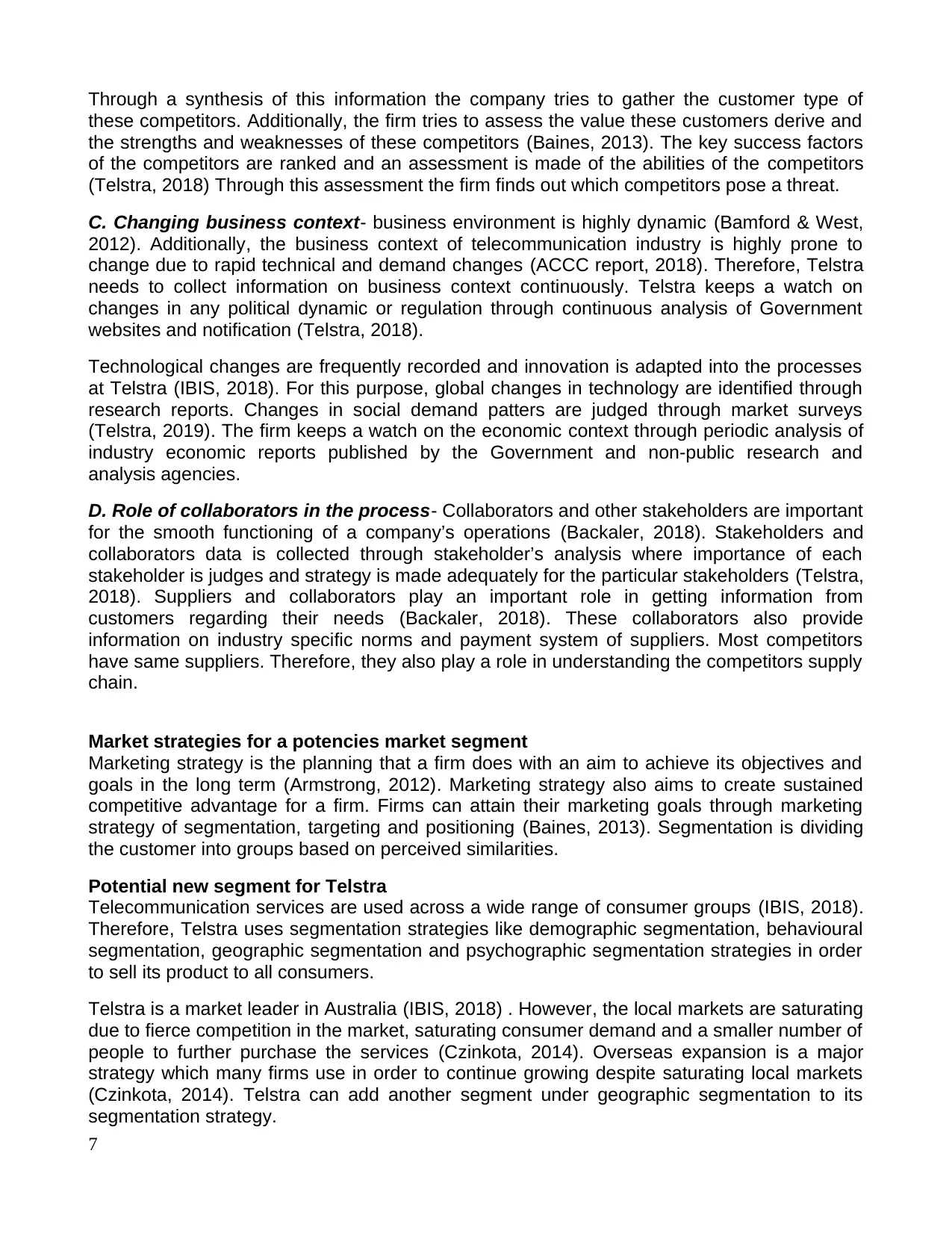
Through a synthesis of this information the company tries to gather the customer type of
these competitors. Additionally, the firm tries to assess the value these customers derive and
the strengths and weaknesses of these competitors (Baines, 2013). The key success factors
of the competitors are ranked and an assessment is made of the abilities of the competitors
(Telstra, 2018) Through this assessment the firm finds out which competitors pose a threat.
C. Changing business context- business environment is highly dynamic (Bamford & West,
2012). Additionally, the business context of telecommunication industry is highly prone to
change due to rapid technical and demand changes (ACCC report, 2018). Therefore, Telstra
needs to collect information on business context continuously. Telstra keeps a watch on
changes in any political dynamic or regulation through continuous analysis of Government
websites and notification (Telstra, 2018).
Technological changes are frequently recorded and innovation is adapted into the processes
at Telstra (IBIS, 2018). For this purpose, global changes in technology are identified through
research reports. Changes in social demand patters are judged through market surveys
(Telstra, 2019). The firm keeps a watch on the economic context through periodic analysis of
industry economic reports published by the Government and non-public research and
analysis agencies.
D. Role of collaborators in the process- Collaborators and other stakeholders are important
for the smooth functioning of a company’s operations (Backaler, 2018). Stakeholders and
collaborators data is collected through stakeholder’s analysis where importance of each
stakeholder is judges and strategy is made adequately for the particular stakeholders (Telstra,
2018). Suppliers and collaborators play an important role in getting information from
customers regarding their needs (Backaler, 2018). These collaborators also provide
information on industry specific norms and payment system of suppliers. Most competitors
have same suppliers. Therefore, they also play a role in understanding the competitors supply
chain.
Market strategies for a potencies market segment
Marketing strategy is the planning that a firm does with an aim to achieve its objectives and
goals in the long term (Armstrong, 2012). Marketing strategy also aims to create sustained
competitive advantage for a firm. Firms can attain their marketing goals through marketing
strategy of segmentation, targeting and positioning (Baines, 2013). Segmentation is dividing
the customer into groups based on perceived similarities.
Potential new segment for Telstra
Telecommunication services are used across a wide range of consumer groups (IBIS, 2018).
Therefore, Telstra uses segmentation strategies like demographic segmentation, behavioural
segmentation, geographic segmentation and psychographic segmentation strategies in order
to sell its product to all consumers.
Telstra is a market leader in Australia (IBIS, 2018) . However, the local markets are saturating
due to fierce competition in the market, saturating consumer demand and a smaller number of
people to further purchase the services (Czinkota, 2014). Overseas expansion is a major
strategy which many firms use in order to continue growing despite saturating local markets
(Czinkota, 2014). Telstra can add another segment under geographic segmentation to its
segmentation strategy.
7
these competitors. Additionally, the firm tries to assess the value these customers derive and
the strengths and weaknesses of these competitors (Baines, 2013). The key success factors
of the competitors are ranked and an assessment is made of the abilities of the competitors
(Telstra, 2018) Through this assessment the firm finds out which competitors pose a threat.
C. Changing business context- business environment is highly dynamic (Bamford & West,
2012). Additionally, the business context of telecommunication industry is highly prone to
change due to rapid technical and demand changes (ACCC report, 2018). Therefore, Telstra
needs to collect information on business context continuously. Telstra keeps a watch on
changes in any political dynamic or regulation through continuous analysis of Government
websites and notification (Telstra, 2018).
Technological changes are frequently recorded and innovation is adapted into the processes
at Telstra (IBIS, 2018). For this purpose, global changes in technology are identified through
research reports. Changes in social demand patters are judged through market surveys
(Telstra, 2019). The firm keeps a watch on the economic context through periodic analysis of
industry economic reports published by the Government and non-public research and
analysis agencies.
D. Role of collaborators in the process- Collaborators and other stakeholders are important
for the smooth functioning of a company’s operations (Backaler, 2018). Stakeholders and
collaborators data is collected through stakeholder’s analysis where importance of each
stakeholder is judges and strategy is made adequately for the particular stakeholders (Telstra,
2018). Suppliers and collaborators play an important role in getting information from
customers regarding their needs (Backaler, 2018). These collaborators also provide
information on industry specific norms and payment system of suppliers. Most competitors
have same suppliers. Therefore, they also play a role in understanding the competitors supply
chain.
Market strategies for a potencies market segment
Marketing strategy is the planning that a firm does with an aim to achieve its objectives and
goals in the long term (Armstrong, 2012). Marketing strategy also aims to create sustained
competitive advantage for a firm. Firms can attain their marketing goals through marketing
strategy of segmentation, targeting and positioning (Baines, 2013). Segmentation is dividing
the customer into groups based on perceived similarities.
Potential new segment for Telstra
Telecommunication services are used across a wide range of consumer groups (IBIS, 2018).
Therefore, Telstra uses segmentation strategies like demographic segmentation, behavioural
segmentation, geographic segmentation and psychographic segmentation strategies in order
to sell its product to all consumers.
Telstra is a market leader in Australia (IBIS, 2018) . However, the local markets are saturating
due to fierce competition in the market, saturating consumer demand and a smaller number of
people to further purchase the services (Czinkota, 2014). Overseas expansion is a major
strategy which many firms use in order to continue growing despite saturating local markets
(Czinkota, 2014). Telstra can add another segment under geographic segmentation to its
segmentation strategy.
7
Paraphrase This Document
Need a fresh take? Get an instant paraphrase of this document with our AI Paraphraser
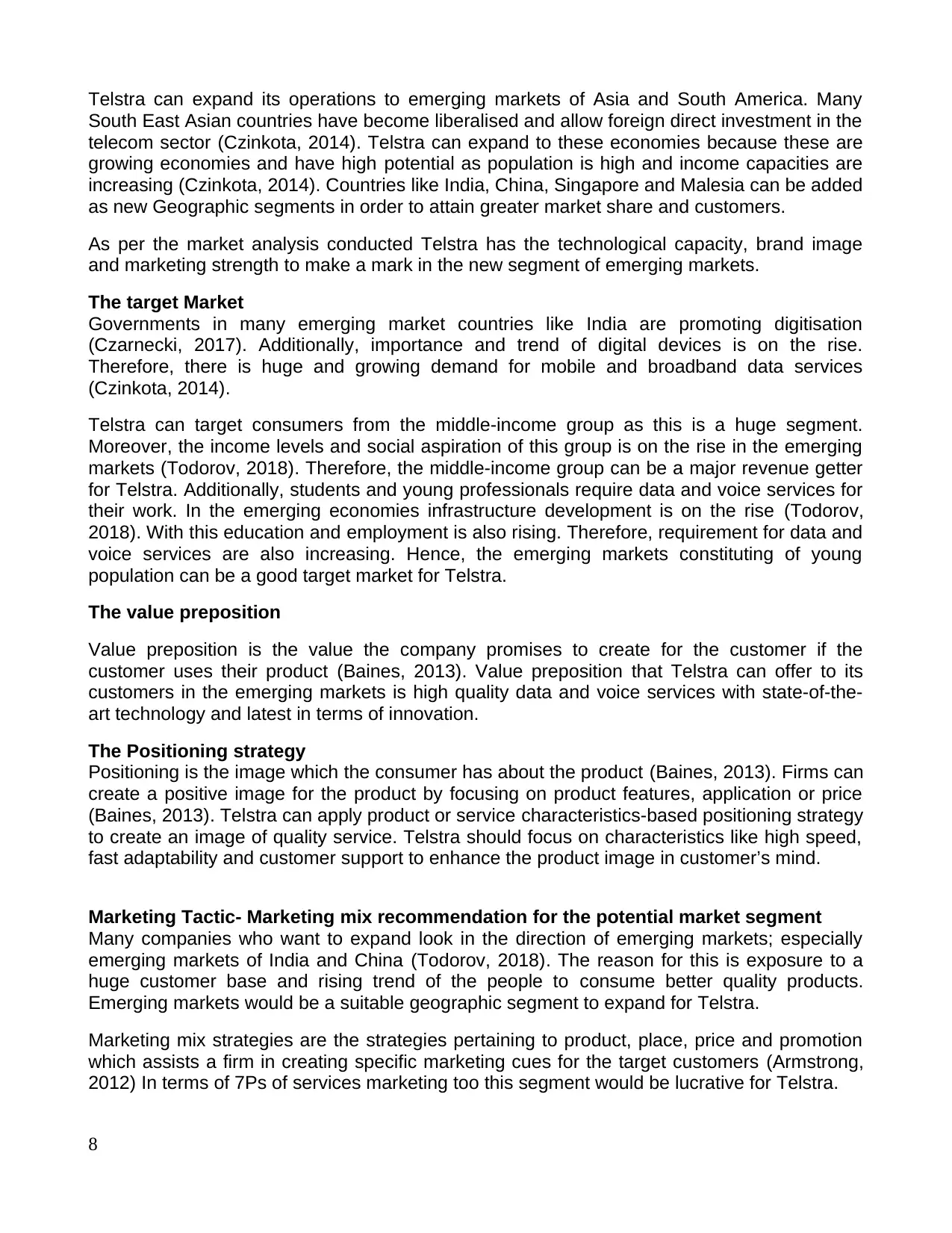
Telstra can expand its operations to emerging markets of Asia and South America. Many
South East Asian countries have become liberalised and allow foreign direct investment in the
telecom sector (Czinkota, 2014). Telstra can expand to these economies because these are
growing economies and have high potential as population is high and income capacities are
increasing (Czinkota, 2014). Countries like India, China, Singapore and Malesia can be added
as new Geographic segments in order to attain greater market share and customers.
As per the market analysis conducted Telstra has the technological capacity, brand image
and marketing strength to make a mark in the new segment of emerging markets.
The target Market
Governments in many emerging market countries like India are promoting digitisation
(Czarnecki, 2017). Additionally, importance and trend of digital devices is on the rise.
Therefore, there is huge and growing demand for mobile and broadband data services
(Czinkota, 2014).
Telstra can target consumers from the middle-income group as this is a huge segment.
Moreover, the income levels and social aspiration of this group is on the rise in the emerging
markets (Todorov, 2018). Therefore, the middle-income group can be a major revenue getter
for Telstra. Additionally, students and young professionals require data and voice services for
their work. In the emerging economies infrastructure development is on the rise (Todorov,
2018). With this education and employment is also rising. Therefore, requirement for data and
voice services are also increasing. Hence, the emerging markets constituting of young
population can be a good target market for Telstra.
The value preposition
Value preposition is the value the company promises to create for the customer if the
customer uses their product (Baines, 2013). Value preposition that Telstra can offer to its
customers in the emerging markets is high quality data and voice services with state-of-the-
art technology and latest in terms of innovation.
The Positioning strategy
Positioning is the image which the consumer has about the product (Baines, 2013). Firms can
create a positive image for the product by focusing on product features, application or price
(Baines, 2013). Telstra can apply product or service characteristics-based positioning strategy
to create an image of quality service. Telstra should focus on characteristics like high speed,
fast adaptability and customer support to enhance the product image in customer’s mind.
Marketing Tactic- Marketing mix recommendation for the potential market segment
Many companies who want to expand look in the direction of emerging markets; especially
emerging markets of India and China (Todorov, 2018). The reason for this is exposure to a
huge customer base and rising trend of the people to consume better quality products.
Emerging markets would be a suitable geographic segment to expand for Telstra.
Marketing mix strategies are the strategies pertaining to product, place, price and promotion
which assists a firm in creating specific marketing cues for the target customers (Armstrong,
2012) In terms of 7Ps of services marketing too this segment would be lucrative for Telstra.
8
South East Asian countries have become liberalised and allow foreign direct investment in the
telecom sector (Czinkota, 2014). Telstra can expand to these economies because these are
growing economies and have high potential as population is high and income capacities are
increasing (Czinkota, 2014). Countries like India, China, Singapore and Malesia can be added
as new Geographic segments in order to attain greater market share and customers.
As per the market analysis conducted Telstra has the technological capacity, brand image
and marketing strength to make a mark in the new segment of emerging markets.
The target Market
Governments in many emerging market countries like India are promoting digitisation
(Czarnecki, 2017). Additionally, importance and trend of digital devices is on the rise.
Therefore, there is huge and growing demand for mobile and broadband data services
(Czinkota, 2014).
Telstra can target consumers from the middle-income group as this is a huge segment.
Moreover, the income levels and social aspiration of this group is on the rise in the emerging
markets (Todorov, 2018). Therefore, the middle-income group can be a major revenue getter
for Telstra. Additionally, students and young professionals require data and voice services for
their work. In the emerging economies infrastructure development is on the rise (Todorov,
2018). With this education and employment is also rising. Therefore, requirement for data and
voice services are also increasing. Hence, the emerging markets constituting of young
population can be a good target market for Telstra.
The value preposition
Value preposition is the value the company promises to create for the customer if the
customer uses their product (Baines, 2013). Value preposition that Telstra can offer to its
customers in the emerging markets is high quality data and voice services with state-of-the-
art technology and latest in terms of innovation.
The Positioning strategy
Positioning is the image which the consumer has about the product (Baines, 2013). Firms can
create a positive image for the product by focusing on product features, application or price
(Baines, 2013). Telstra can apply product or service characteristics-based positioning strategy
to create an image of quality service. Telstra should focus on characteristics like high speed,
fast adaptability and customer support to enhance the product image in customer’s mind.
Marketing Tactic- Marketing mix recommendation for the potential market segment
Many companies who want to expand look in the direction of emerging markets; especially
emerging markets of India and China (Todorov, 2018). The reason for this is exposure to a
huge customer base and rising trend of the people to consume better quality products.
Emerging markets would be a suitable geographic segment to expand for Telstra.
Marketing mix strategies are the strategies pertaining to product, place, price and promotion
which assists a firm in creating specific marketing cues for the target customers (Armstrong,
2012) In terms of 7Ps of services marketing too this segment would be lucrative for Telstra.
8
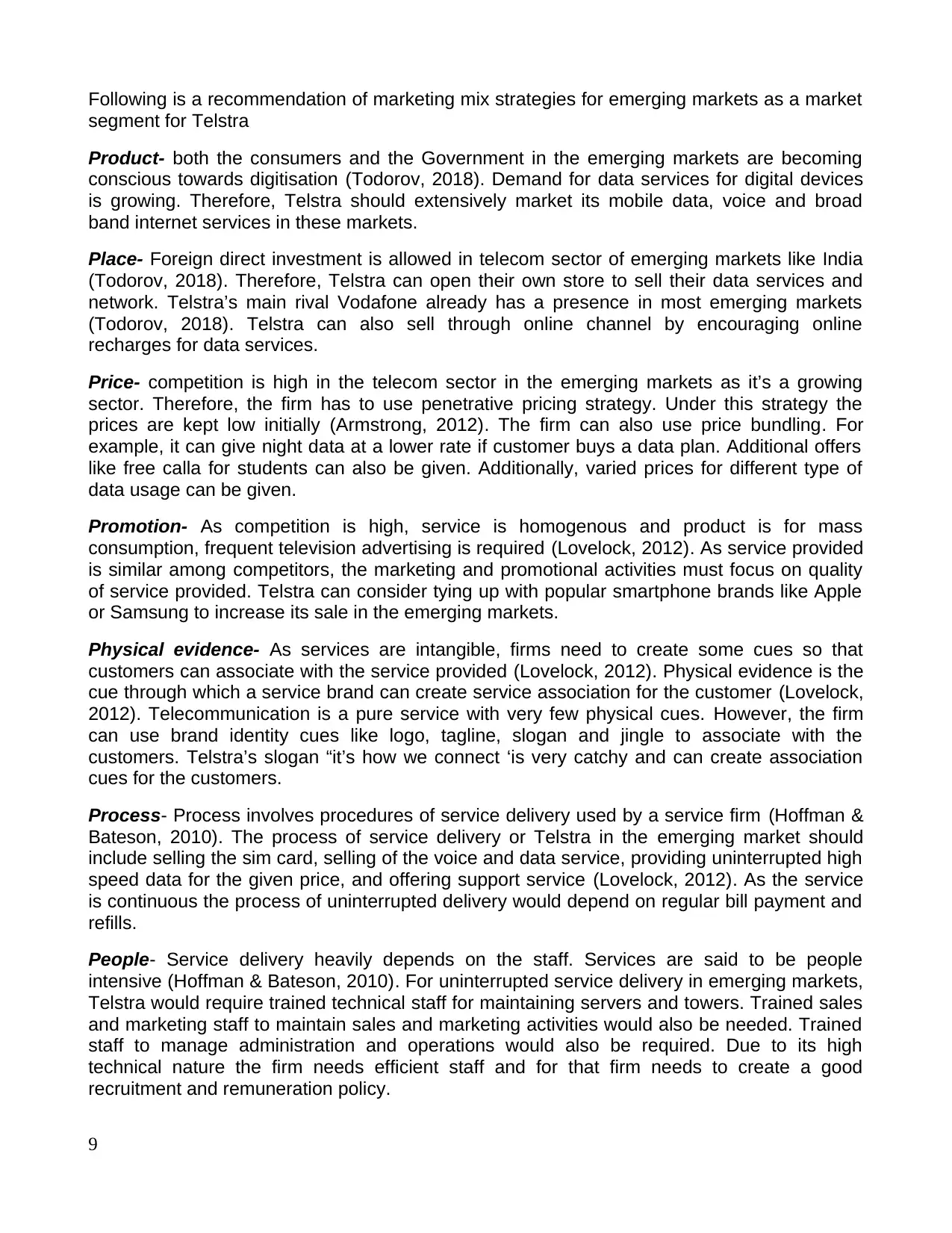
Following is a recommendation of marketing mix strategies for emerging markets as a market
segment for Telstra
Product- both the consumers and the Government in the emerging markets are becoming
conscious towards digitisation (Todorov, 2018). Demand for data services for digital devices
is growing. Therefore, Telstra should extensively market its mobile data, voice and broad
band internet services in these markets.
Place- Foreign direct investment is allowed in telecom sector of emerging markets like India
(Todorov, 2018). Therefore, Telstra can open their own store to sell their data services and
network. Telstra’s main rival Vodafone already has a presence in most emerging markets
(Todorov, 2018). Telstra can also sell through online channel by encouraging online
recharges for data services.
Price- competition is high in the telecom sector in the emerging markets as it’s a growing
sector. Therefore, the firm has to use penetrative pricing strategy. Under this strategy the
prices are kept low initially (Armstrong, 2012). The firm can also use price bundling. For
example, it can give night data at a lower rate if customer buys a data plan. Additional offers
like free calla for students can also be given. Additionally, varied prices for different type of
data usage can be given.
Promotion- As competition is high, service is homogenous and product is for mass
consumption, frequent television advertising is required (Lovelock, 2012). As service provided
is similar among competitors, the marketing and promotional activities must focus on quality
of service provided. Telstra can consider tying up with popular smartphone brands like Apple
or Samsung to increase its sale in the emerging markets.
Physical evidence- As services are intangible, firms need to create some cues so that
customers can associate with the service provided (Lovelock, 2012). Physical evidence is the
cue through which a service brand can create service association for the customer (Lovelock,
2012). Telecommunication is a pure service with very few physical cues. However, the firm
can use brand identity cues like logo, tagline, slogan and jingle to associate with the
customers. Telstra’s slogan “it’s how we connect ‘is very catchy and can create association
cues for the customers.
Process- Process involves procedures of service delivery used by a service firm (Hoffman &
Bateson, 2010). The process of service delivery or Telstra in the emerging market should
include selling the sim card, selling of the voice and data service, providing uninterrupted high
speed data for the given price, and offering support service (Lovelock, 2012). As the service
is continuous the process of uninterrupted delivery would depend on regular bill payment and
refills.
People- Service delivery heavily depends on the staff. Services are said to be people
intensive (Hoffman & Bateson, 2010). For uninterrupted service delivery in emerging markets,
Telstra would require trained technical staff for maintaining servers and towers. Trained sales
and marketing staff to maintain sales and marketing activities would also be needed. Trained
staff to manage administration and operations would also be required. Due to its high
technical nature the firm needs efficient staff and for that firm needs to create a good
recruitment and remuneration policy.
9
segment for Telstra
Product- both the consumers and the Government in the emerging markets are becoming
conscious towards digitisation (Todorov, 2018). Demand for data services for digital devices
is growing. Therefore, Telstra should extensively market its mobile data, voice and broad
band internet services in these markets.
Place- Foreign direct investment is allowed in telecom sector of emerging markets like India
(Todorov, 2018). Therefore, Telstra can open their own store to sell their data services and
network. Telstra’s main rival Vodafone already has a presence in most emerging markets
(Todorov, 2018). Telstra can also sell through online channel by encouraging online
recharges for data services.
Price- competition is high in the telecom sector in the emerging markets as it’s a growing
sector. Therefore, the firm has to use penetrative pricing strategy. Under this strategy the
prices are kept low initially (Armstrong, 2012). The firm can also use price bundling. For
example, it can give night data at a lower rate if customer buys a data plan. Additional offers
like free calla for students can also be given. Additionally, varied prices for different type of
data usage can be given.
Promotion- As competition is high, service is homogenous and product is for mass
consumption, frequent television advertising is required (Lovelock, 2012). As service provided
is similar among competitors, the marketing and promotional activities must focus on quality
of service provided. Telstra can consider tying up with popular smartphone brands like Apple
or Samsung to increase its sale in the emerging markets.
Physical evidence- As services are intangible, firms need to create some cues so that
customers can associate with the service provided (Lovelock, 2012). Physical evidence is the
cue through which a service brand can create service association for the customer (Lovelock,
2012). Telecommunication is a pure service with very few physical cues. However, the firm
can use brand identity cues like logo, tagline, slogan and jingle to associate with the
customers. Telstra’s slogan “it’s how we connect ‘is very catchy and can create association
cues for the customers.
Process- Process involves procedures of service delivery used by a service firm (Hoffman &
Bateson, 2010). The process of service delivery or Telstra in the emerging market should
include selling the sim card, selling of the voice and data service, providing uninterrupted high
speed data for the given price, and offering support service (Lovelock, 2012). As the service
is continuous the process of uninterrupted delivery would depend on regular bill payment and
refills.
People- Service delivery heavily depends on the staff. Services are said to be people
intensive (Hoffman & Bateson, 2010). For uninterrupted service delivery in emerging markets,
Telstra would require trained technical staff for maintaining servers and towers. Trained sales
and marketing staff to maintain sales and marketing activities would also be needed. Trained
staff to manage administration and operations would also be required. Due to its high
technical nature the firm needs efficient staff and for that firm needs to create a good
recruitment and remuneration policy.
9
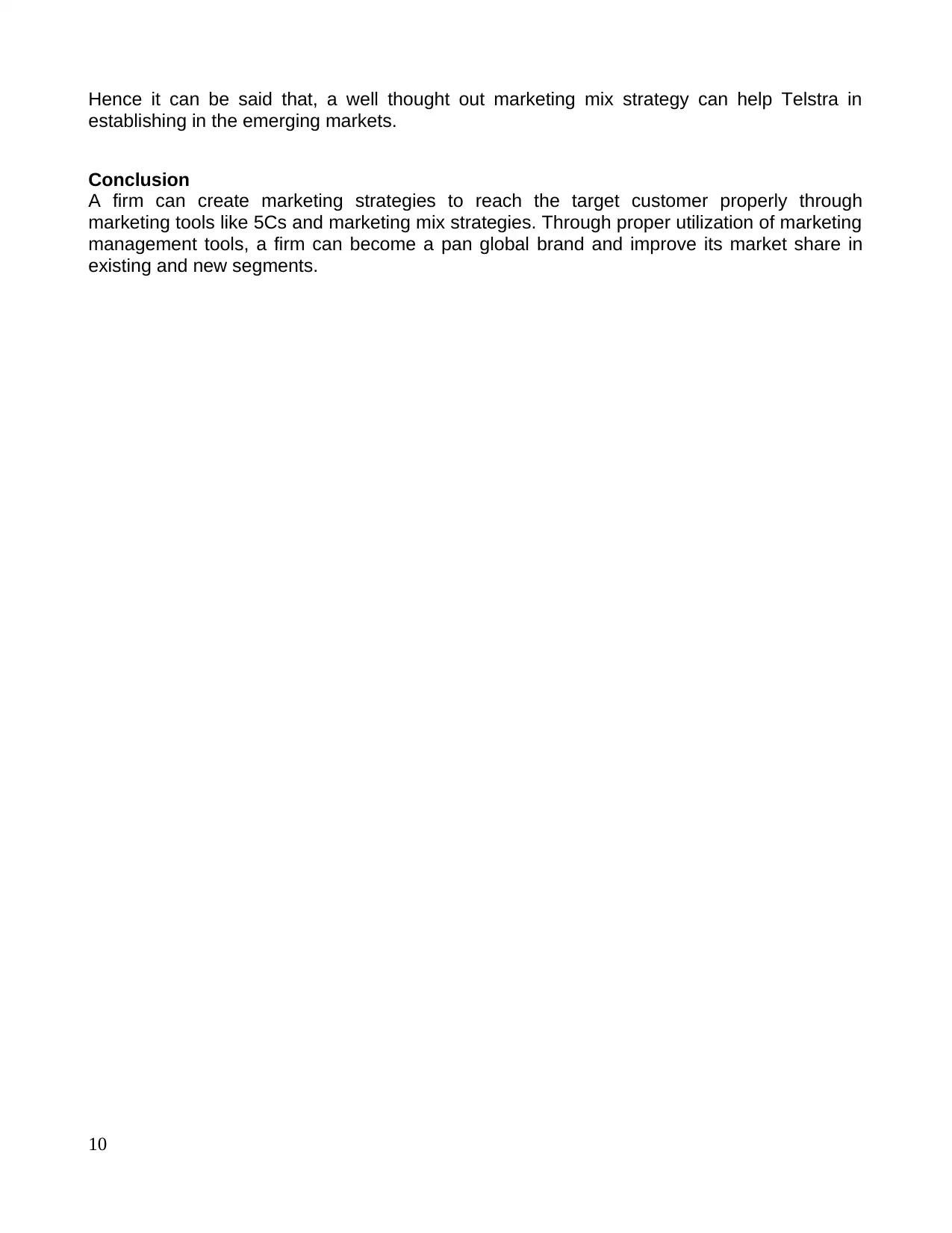
Hence it can be said that, a well thought out marketing mix strategy can help Telstra in
establishing in the emerging markets.
Conclusion
A firm can create marketing strategies to reach the target customer properly through
marketing tools like 5Cs and marketing mix strategies. Through proper utilization of marketing
management tools, a firm can become a pan global brand and improve its market share in
existing and new segments.
10
establishing in the emerging markets.
Conclusion
A firm can create marketing strategies to reach the target customer properly through
marketing tools like 5Cs and marketing mix strategies. Through proper utilization of marketing
management tools, a firm can become a pan global brand and improve its market share in
existing and new segments.
10
Secure Best Marks with AI Grader
Need help grading? Try our AI Grader for instant feedback on your assignments.
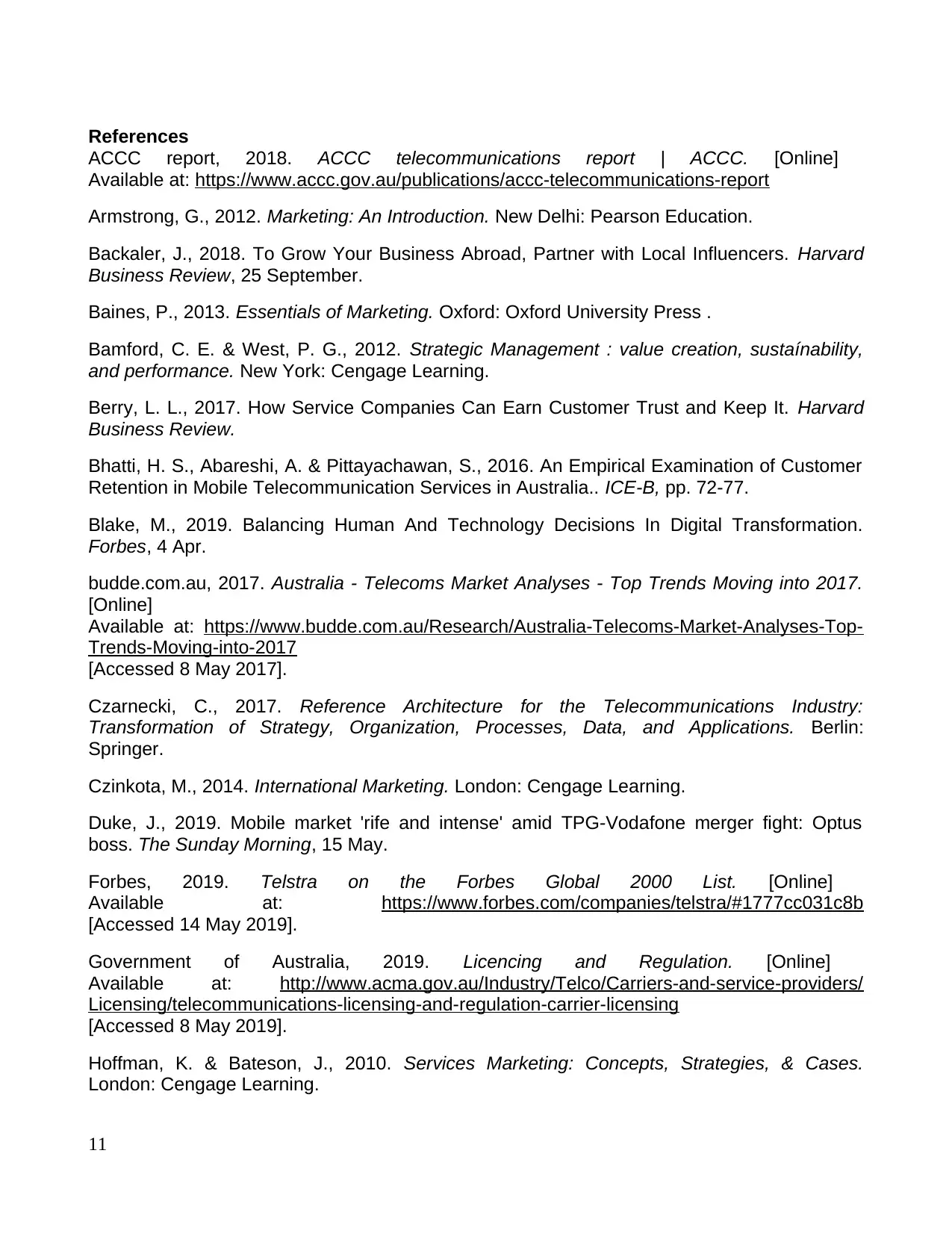
References
ACCC report, 2018. ACCC telecommunications report | ACCC. [Online]
Available at: https://www.accc.gov.au/publications/accc-telecommunications-report
Armstrong, G., 2012. Marketing: An Introduction. New Delhi: Pearson Education.
Backaler, J., 2018. To Grow Your Business Abroad, Partner with Local Influencers. Harvard
Business Review, 25 September.
Baines, P., 2013. Essentials of Marketing. Oxford: Oxford University Press .
Bamford, C. E. & West, P. G., 2012. Strategic Management : value creation, sustaínability,
and performance. New York: Cengage Learning.
Berry, L. L., 2017. How Service Companies Can Earn Customer Trust and Keep It. Harvard
Business Review.
Bhatti, H. S., Abareshi, A. & Pittayachawan, S., 2016. An Empirical Examination of Customer
Retention in Mobile Telecommunication Services in Australia.. ICE-B, pp. 72-77.
Blake, M., 2019. Balancing Human And Technology Decisions In Digital Transformation.
Forbes, 4 Apr.
budde.com.au, 2017. Australia - Telecoms Market Analyses - Top Trends Moving into 2017.
[Online]
Available at: https://www.budde.com.au/Research/Australia-Telecoms-Market-Analyses-Top-
Trends-Moving-into-2017
[Accessed 8 May 2017].
Czarnecki, C., 2017. Reference Architecture for the Telecommunications Industry:
Transformation of Strategy, Organization, Processes, Data, and Applications. Berlin:
Springer.
Czinkota, M., 2014. International Marketing. London: Cengage Learning.
Duke, J., 2019. Mobile market 'rife and intense' amid TPG-Vodafone merger fight: Optus
boss. The Sunday Morning, 15 May.
Forbes, 2019. Telstra on the Forbes Global 2000 List. [Online]
Available at: https://www.forbes.com/companies/telstra/#1777cc031c8b
[Accessed 14 May 2019].
Government of Australia, 2019. Licencing and Regulation. [Online]
Available at: http://www.acma.gov.au/Industry/Telco/Carriers-and-service-providers/
Licensing/telecommunications-licensing-and-regulation-carrier-licensing
[Accessed 8 May 2019].
Hoffman, K. & Bateson, J., 2010. Services Marketing: Concepts, Strategies, & Cases.
London: Cengage Learning.
11
ACCC report, 2018. ACCC telecommunications report | ACCC. [Online]
Available at: https://www.accc.gov.au/publications/accc-telecommunications-report
Armstrong, G., 2012. Marketing: An Introduction. New Delhi: Pearson Education.
Backaler, J., 2018. To Grow Your Business Abroad, Partner with Local Influencers. Harvard
Business Review, 25 September.
Baines, P., 2013. Essentials of Marketing. Oxford: Oxford University Press .
Bamford, C. E. & West, P. G., 2012. Strategic Management : value creation, sustaínability,
and performance. New York: Cengage Learning.
Berry, L. L., 2017. How Service Companies Can Earn Customer Trust and Keep It. Harvard
Business Review.
Bhatti, H. S., Abareshi, A. & Pittayachawan, S., 2016. An Empirical Examination of Customer
Retention in Mobile Telecommunication Services in Australia.. ICE-B, pp. 72-77.
Blake, M., 2019. Balancing Human And Technology Decisions In Digital Transformation.
Forbes, 4 Apr.
budde.com.au, 2017. Australia - Telecoms Market Analyses - Top Trends Moving into 2017.
[Online]
Available at: https://www.budde.com.au/Research/Australia-Telecoms-Market-Analyses-Top-
Trends-Moving-into-2017
[Accessed 8 May 2017].
Czarnecki, C., 2017. Reference Architecture for the Telecommunications Industry:
Transformation of Strategy, Organization, Processes, Data, and Applications. Berlin:
Springer.
Czinkota, M., 2014. International Marketing. London: Cengage Learning.
Duke, J., 2019. Mobile market 'rife and intense' amid TPG-Vodafone merger fight: Optus
boss. The Sunday Morning, 15 May.
Forbes, 2019. Telstra on the Forbes Global 2000 List. [Online]
Available at: https://www.forbes.com/companies/telstra/#1777cc031c8b
[Accessed 14 May 2019].
Government of Australia, 2019. Licencing and Regulation. [Online]
Available at: http://www.acma.gov.au/Industry/Telco/Carriers-and-service-providers/
Licensing/telecommunications-licensing-and-regulation-carrier-licensing
[Accessed 8 May 2019].
Hoffman, K. & Bateson, J., 2010. Services Marketing: Concepts, Strategies, & Cases.
London: Cengage Learning.
11
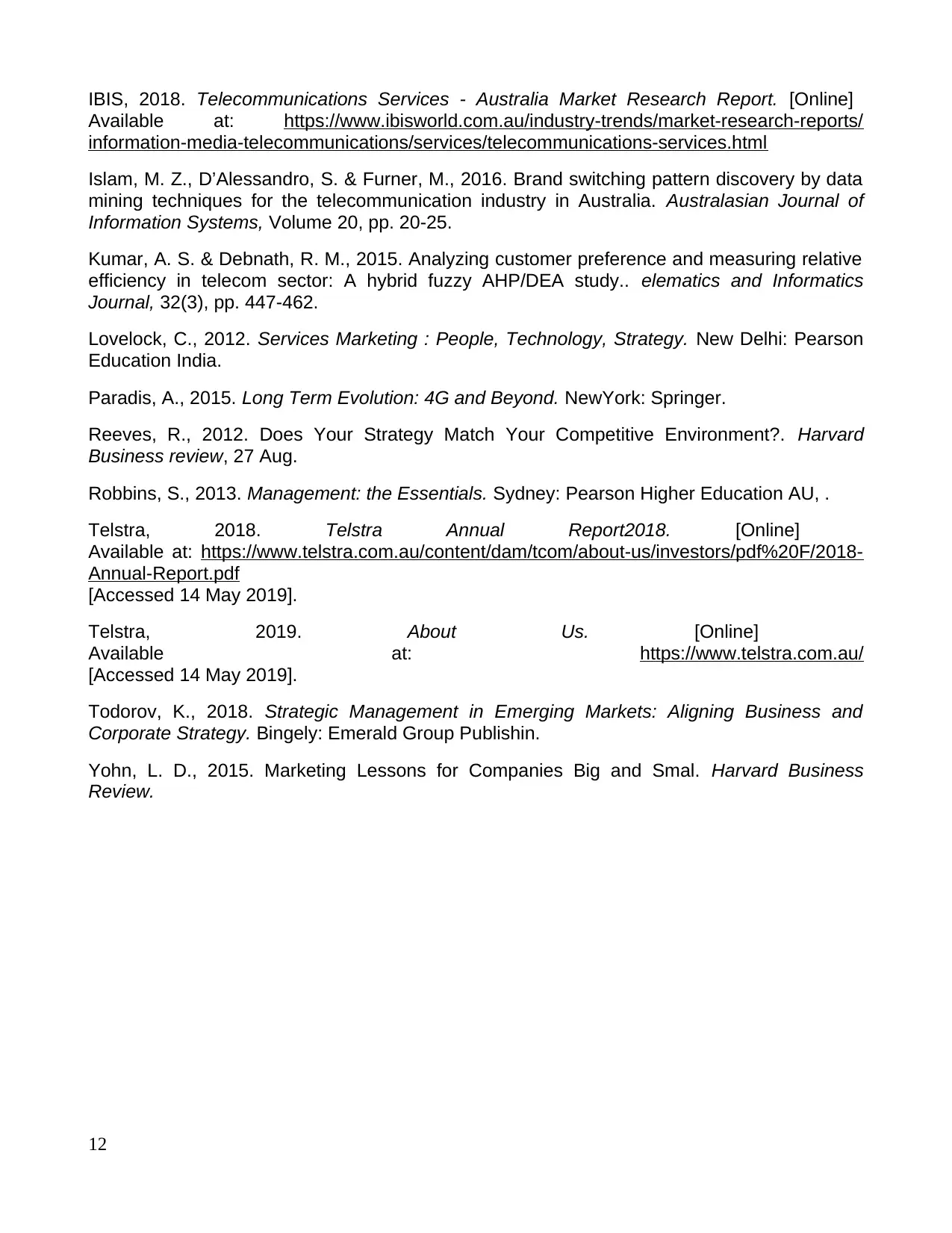
IBIS, 2018. Telecommunications Services - Australia Market Research Report. [Online]
Available at: https://www.ibisworld.com.au/industry-trends/market-research-reports/
information-media-telecommunications/services/telecommunications-services.html
Islam, M. Z., D’Alessandro, S. & Furner, M., 2016. Brand switching pattern discovery by data
mining techniques for the telecommunication industry in Australia. Australasian Journal of
Information Systems, Volume 20, pp. 20-25.
Kumar, A. S. & Debnath, R. M., 2015. Analyzing customer preference and measuring relative
efficiency in telecom sector: A hybrid fuzzy AHP/DEA study.. elematics and Informatics
Journal, 32(3), pp. 447-462.
Lovelock, C., 2012. Services Marketing : People, Technology, Strategy. New Delhi: Pearson
Education India.
Paradis, A., 2015. Long Term Evolution: 4G and Beyond. NewYork: Springer.
Reeves, R., 2012. Does Your Strategy Match Your Competitive Environment?. Harvard
Business review, 27 Aug.
Robbins, S., 2013. Management: the Essentials. Sydney: Pearson Higher Education AU, .
Telstra, 2018. Telstra Annual Report2018. [Online]
Available at: https://www.telstra.com.au/content/dam/tcom/about-us/investors/pdf%20F/2018-
Annual-Report.pdf
[Accessed 14 May 2019].
Telstra, 2019. About Us. [Online]
Available at: https://www.telstra.com.au/
[Accessed 14 May 2019].
Todorov, K., 2018. Strategic Management in Emerging Markets: Aligning Business and
Corporate Strategy. Bingely: Emerald Group Publishin.
Yohn, L. D., 2015. Marketing Lessons for Companies Big and Smal. Harvard Business
Review.
12
Available at: https://www.ibisworld.com.au/industry-trends/market-research-reports/
information-media-telecommunications/services/telecommunications-services.html
Islam, M. Z., D’Alessandro, S. & Furner, M., 2016. Brand switching pattern discovery by data
mining techniques for the telecommunication industry in Australia. Australasian Journal of
Information Systems, Volume 20, pp. 20-25.
Kumar, A. S. & Debnath, R. M., 2015. Analyzing customer preference and measuring relative
efficiency in telecom sector: A hybrid fuzzy AHP/DEA study.. elematics and Informatics
Journal, 32(3), pp. 447-462.
Lovelock, C., 2012. Services Marketing : People, Technology, Strategy. New Delhi: Pearson
Education India.
Paradis, A., 2015. Long Term Evolution: 4G and Beyond. NewYork: Springer.
Reeves, R., 2012. Does Your Strategy Match Your Competitive Environment?. Harvard
Business review, 27 Aug.
Robbins, S., 2013. Management: the Essentials. Sydney: Pearson Higher Education AU, .
Telstra, 2018. Telstra Annual Report2018. [Online]
Available at: https://www.telstra.com.au/content/dam/tcom/about-us/investors/pdf%20F/2018-
Annual-Report.pdf
[Accessed 14 May 2019].
Telstra, 2019. About Us. [Online]
Available at: https://www.telstra.com.au/
[Accessed 14 May 2019].
Todorov, K., 2018. Strategic Management in Emerging Markets: Aligning Business and
Corporate Strategy. Bingely: Emerald Group Publishin.
Yohn, L. D., 2015. Marketing Lessons for Companies Big and Smal. Harvard Business
Review.
12
1 out of 12
Related Documents
Your All-in-One AI-Powered Toolkit for Academic Success.
+13062052269
info@desklib.com
Available 24*7 on WhatsApp / Email
![[object Object]](/_next/static/media/star-bottom.7253800d.svg)
Unlock your academic potential
© 2024 | Zucol Services PVT LTD | All rights reserved.





